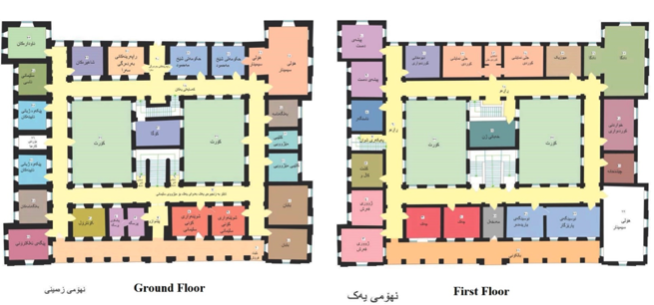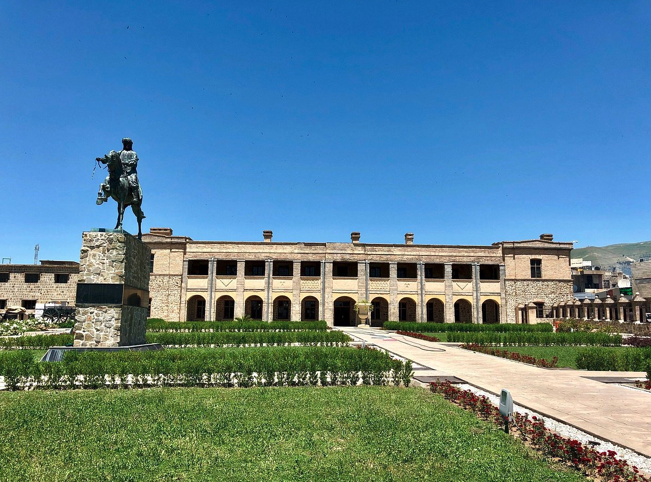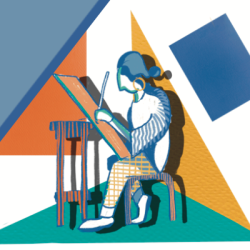Exploring Artistic Horizons: TPH's Inaugural Digital Art Session
Slemani Sara: A Journey through History
By: Asan Azad Masraf

Photo: old version of Sara, a famous old downtown and center of Slemani city. During the League of Nations mandate of United Kingdom Troops period during the early 1920s
Sulaimanyah Sara (Slemani Palace) also spelled, as Slemani Sara is a large square in Sulaimani, located in the center of the city, six streets have located streets of Mawlawi, Kawa, Goran, Sabunkaran, Bekas, and Peeramerd
Sara Building, a cultural center in Slemani that has witnessed many historical events: Sara Building is one of the historical sights and the cultural center of Slemani city witnessed many historical events. Slemani, also called Sulaymaniyah, is a city in the east of the Kurdistan Region of Iraq, not far from the Iran–Iraq border.
Slemani is surrounded by the Azmar, Goyzha, and Qaywan Mountains from the northeast, Baranan Mountain from the south, and the Tasluja Hills from the west. The modern city of Slemani was founded in 1784 by the Kurdish prince Ibrahim Pasha Baban, who named it after his father, Sulaiman Pasha.
When the Baban dynasty came to the city, they moved their capital from Qalachwalan to Slemani. From 1784 to 1850, it was the capital of the historic principality of Baban. The first thing the Baban did was build a place for the government, so they built the Sara building.
Slemani Sara, also known as Sulaymaniyah Palace, is a large square in Sulaimani, located in the center of the city. It was built in 1784 by the Kurdish prince Ibrahim Pasha Baban, who named it after his father, Sulaiman Pasha. Sara has been through a lot of changes over the years. It was used as a military barracks during the Ottoman Empire, and it was also damaged during the Iran-Iraq War. In recent years, the Sara has been restored and it is now a cultural center. It houses a museum, a library, and a theater. The Sara is a popular tourist destination and it is a reminder of the rich history of Sulaimani.
In the past, Sara was the center of attention of the citizens and authorities of the city and many government offices were located there, in addition to the first Kurdish government was announced on it.
Rafiq Salih, a historian and expert in the field of documents, says that the history of the palace/Sara dates back to the Baban period. He added that on 17-11-1918, Major Noel, the British Sami envoy in Baghdad, proclaimed Sheikh Mahmoud Hafid as the first king of Kurdistan, which is an important event in the history of Sulaimani and the Kurds.
Ibrahim Pasha of Baban founded Sulaymaniyah on November 14, 1784, when he moved the capital of his empire from Ardalan to Sulaymaniyah.

Photo: Bar Darki Sara, a famous old downtown and center of Slemani city. This square became famous after the 1930 demonstrations.
Moreover, Sara or Bardarki Sara (in front of the door of the palace), with the establishment of Sulaymaniyah, the Baban emirs allocated a place for the headquarters of their power known as the palace as shown in the picture above. The idea of building this palace seems to have come about after the establishment of the monarchy. Built in 1926–1928 in the center of Sulaimani, the palace consists of 2 floors and 43 rooms. It was then devoted to the administrative position of the police and the governor's office as clear and shown in the picture below. Now the Sulaimani province and the Sulaimani Archaeological Directorate to restored its original style a historical, political, and national museum have restored it.
The region of Sulaymaniyah was known as Zamwa before the foundation of the modern city in 1784. The capital of the Kurdish Baban principality (1649–1850), before Sulaymaniyah, was a territory named "Qelaçiwalan". At the time of the Babani's rule, there were major conflicts between the Safavid dynasty and the Ottoman Empire. Qelaçiwalan became a battleground for the two rivals.
Being of strategic importance and lying deep inside Safavid territory, there was concern that Qelaçiwalan would be attacked and captured if the Babani did not give the Safavids military support, as both Sultan Mahmud II and Nader Shah were trying to gain the support of the dispersed Kurdish Emirates. This obliged Mahmud Pasha of Baban in 1781 to think about moving the center of the emirate to a safer place. He chose Melkendî, then a village but now a district in central Sulaymaniyah, to construct several (serahs) for his political and armed units.
In 1783, Ibrahim Pasha Baban became ruler of the emirate and began the reconstruction of a city which was once constructed by Ottoman Sultan Sulaiman (the name of Sulaimaniyah came from his name) new city which would become its capital. In 1784, he finished erecting several palaces for trade called Qeyserîs and bazaars, which were also used as baths, and began inviting people from the surrounding villages and emirates to move to the newly established city. Soon Melkendî, which was originally intended to be the city itself, instead became one of its quarters. The new city of Sulaymaniyah was named after Sulaiman Baban, who was the first Baban prince to gain control of the province of Şarezûr. Sulaiman Baban invaded the neighboring Kurdish vassaldom of Ardalan, defeating their forces in 1694. Ottoman Sultan Mustafa II assigned him the district of Baban.
In the early 1800s refugees from Ardalan moved to Sulaymaniyah, including Mastura Ardalan, the widow of Xosraw Xanî Erdalan, the ruler of the kingdom. Erdalan wrote an account of Kurdish history in Persian and was buried in Sulaymaniyah when he died in 1848.
From 1922 to 1924, Sulaymaniyah was the capital of the Kingdom of Kurdistan, a short-lived unrecognized state declared by Iraqi Kurds following the collapse of the Ottoman Empire.
Meanwhile, the famous Kurdish poet Sheikh Reza Talabani referred to it in a famous poem and said, I remember Slemani, which was the property of the Babans, was not ruled by foreigners or mocked by the Othman Empire.
On September 6, 1930, for the first time as a new invention of civil struggle in Sulaimani, a demonstration against the British was held in front of the Sara. In addition, in 1956, when the body of the Kurdistan King Sheikh Mahmoud Hafeed was brought back to Sulaimani, a clash broke out between the supporters of the Kurdistan King and the authorities, and the wife of the artist Rashol was martyred.
The Sara was the headquarters of the emir during the Baban dynasty and the government's headquarters during the reign of the late Sheikh Mahmoud. Several political and administrative agreements were signed there It is the Sulaimani Administration Building.
The Sara was built in 1784 by Ibrahim Pasha Baban, the founder of the city of Sulaimani. The Sara was initially used as the seat of government for the Baban dynasty. After the fall of the Baban dynasty, the Sara was used by the Ottoman Empire as a military barracks. In the early 20th century, the Sara was damaged during the Iran-Iraq War. In recent years, the Sara has been restored and it is now a cultural center.
The Sara is a Two-storey building with a central courtyard. The building is made of mudbrick and has a traditional Kurdish design. The Sara has many arched doorways and windows. The interior of the Sara is decorated with traditional Kurdish motifs.

Photo: Sara, this demonstrates two floors and each room. (Map of Sulaimani Palace dates back to 1775 when it was built by Mahmud Pasha, uncle of Ibrahim Pasha, Emir of Baban, and was first used as a khan.)
In his trip to Sulaimani in 1908, Majorson mentioned Khani Ajam, Khani Ghafoor Agha, Qaiser Wasman Pasha, and Qaiser Naqib Before the arrival of Majorson, these khans and emperors existed in Sulaimani. Now only the Naqib Caesar remains intact, but the other khans and emperors are no longer there and their places are now shops and markets Hundreds of shops and markets have been built in the neighborhoods.
Here are some of the important events that have taken place at the Sara:
• The inauguration ceremony of the first Kurdish king, Sheikh Mahmoud Hafeed, in 1918, in front of Sara, the first capital of the Kurdish government.
• In 1930, a mass demonstration was held in front of the Sara to protest against British rule.
• In 1956, a mass demonstration was held in front of the Sara to mourn the death of Sheikh Mahmoud Hafeed.
Regarding Sara building, based on an interview with Mr. Muhammad Baqi Saeed, a veteran teacher, and co-founder of the Kurdistan Teachers Union. The history of Sara building during the Baban era "In the beginning, Sara was a simple one-floor building," Baqi stated.
"Time went by, Ottoman Empire came intending to wipe every emirate of the Baban dynasty and began attacking the area with their army and destroyed the Baban in around 1850 and the Turkish ruling began in Slemani," Baqi added. While speaking about the Ottoman era, Mr. Baqi revealed that the Ottomans committed many horrible atrocities and began Turkification of the Slemani regions and their names until the First World War.
What happened to the Sara Building after WW1
Mr. Baqi explained that after the First World War, the English occupied Slemani, and they reconstructed the Sara Building, turning it into the city's administration base.
"They renovated the whole city and brought printing houses,
Slemani's Sara building during the foundation of Iraq
Mr. Baqi stated, "During the times of the foundation of Iraqi country, Iraq was three parts, and none of the parts were related to each other, but in an agreement, they combined the parts and built the country Iraq. After that, Slemani became a governorate."
"Back then, Slemani was so small, and all the government institutions were in the Sara building. It only had a gate, and tall trees were surrounding the road that led to the building," he added.

Photo: Sara, The modern picture and after the latest renovation.
The Sara is a symbol of Kurdish identity and it is a reminder of the struggle for Kurdish independence. It is an important part of the history of Sulaimani and it is a popular tourist destination
In recent years, the authorities of Slemani have renovated the building, and it has been a cultural center of Slemani since then. The Sara is a significant historical and cultural landmark. It is a reminder of the rich history of Sulaimani and the Kurdish people. The Sara is also a popular tourist destination.
